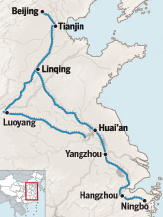

The Forbidden City
The Grand Canal runs through dozens of cities. But the exhibition sheds light on the particularly close relationship between the canal system and Beijing, the destination of the waterways' expenditure and the imperial city of the Yuan (1271-1368), Ming and Qing (1644-1911) dynasties.
The Grand Canal facilitated the time-consuming journeys of laborers and materials for the construction of the Forbidden City, which marked its 600th anniversary in 2020.
Zhao says the palace complex was built using advanced techniques and craftsmanship from different parts of the country.
"For example, resources like the bricks fired in Linqing, Shandong province, and Suzhou in Jiangsu, and gigantic timber cut in Hunan province were transported to the imperial city along the canal's various sections," he says.
Wei Jihong was a worker at a brickyard in Zhangjiawan, in today's Tongzhou district of Beijing, who oversaw the royal bricks' arrival from the south. His name and responsibility are inscribed on a large block shown at the exhibition.
Wei's workplace was piled high with quality bricks manufactured at official kilns in Jiangsu, Anhui, Henan and Shandong provinces, intended for the Forbidden City's construction.
The cube-shaped blocks fired in Suzhou were deemed "golden bricks "because of their superior quality. Producing a "golden brick" involved complicated techniques and typically took a year, after which it was shipped along the canal to Tongzhou's port.
There, the bricks were unloaded and transported by carriage to the Forbidden City, where they created palace floors.
The Grand Canal should even be credited with the origin of Peking roast duck, which was once an imperial dish.
A short animation played at the exhibition shows that white lake ducks endemic to the south were shipped to Beijing. They were later domesticated to produce Peking roast duck.
According to the animation, large quantities of goods were transported along the canal system after Zhu Di, or Ming emperor Yongle, moved the capital from Nanjing to Beijing. When the cargo boats closed in on Beijing, grain would fall into the water from broken bags. Consequently, the ducks raised in nearby villages were found to possess quality meat.
The preparation method is also believed to have been first mastered by royal-court chefs in Nanjing and later brought to Beijing so Zhu Di could still savor the delicacy. A century later, the recipe moved beyond the imperial city, into the civilian world.
Shan Jixiang, former director of the Palace Museum (Forbidden City), says that because many materials used to build the compound arrived in Beijing via the Grand Canal, ancient Beijing was, in some ways, "formed by and flowed from the canal".
"The Great Wall symbolizes the firm backbone of China, while the Grand Canal is the bloodline that flows through the hearts of Chinese people," he says.
"This artificial waterway that runs across the nation is also a spiritual haven for millions."